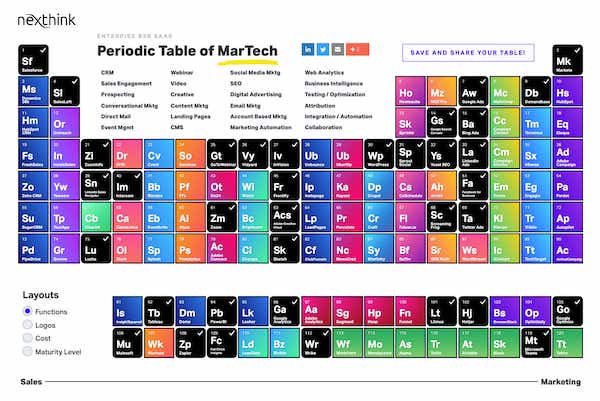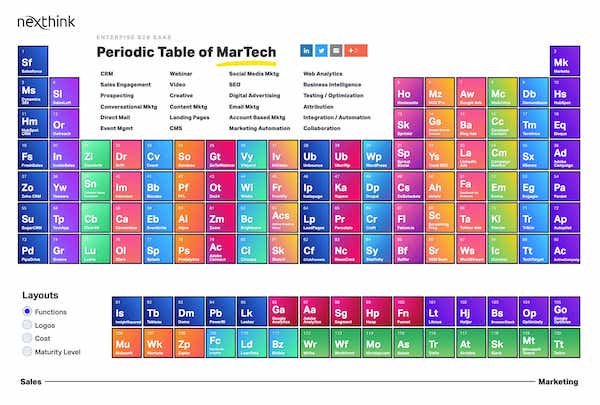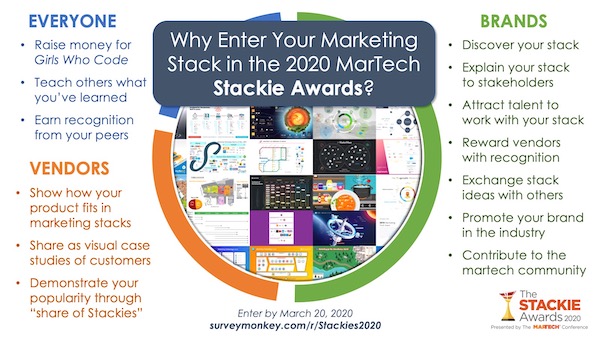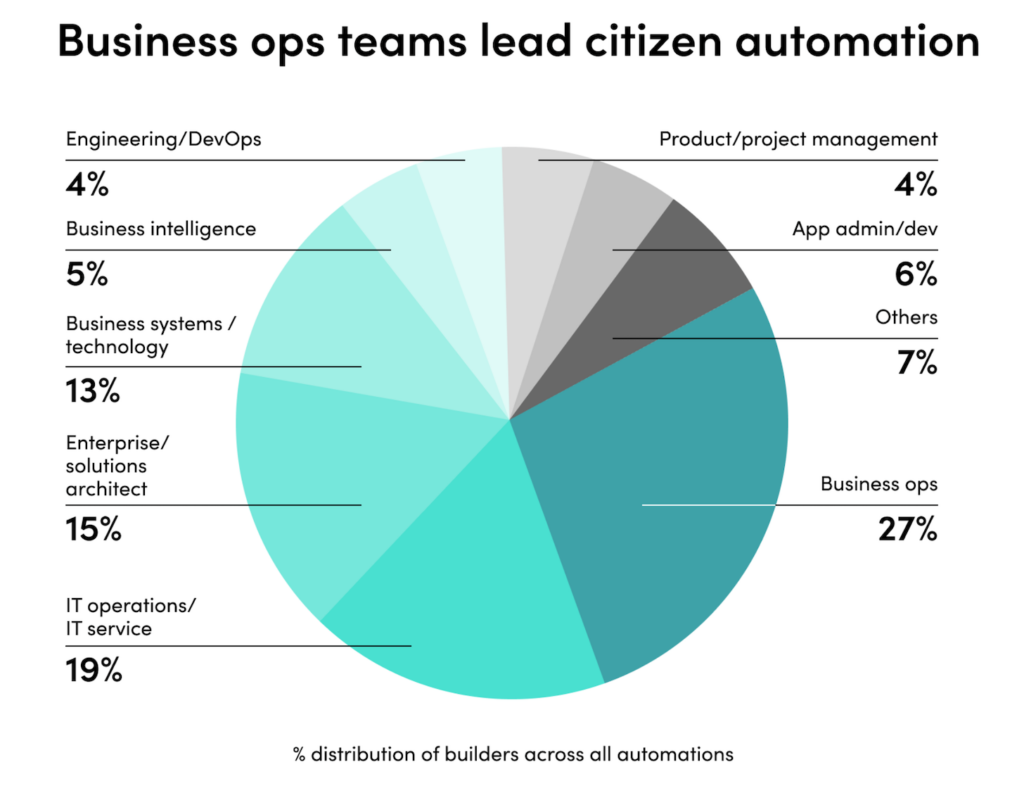Happy New Year!
To kick off 2020, I’m excited to share one of the first entries into The Stackies 2020: Marketing Stack Awards from Nexthink, an enterprise platform that help IT departments deliver great digital employee experiences.
Jon Blumenfeld, Nexthink’s director of digital marketing, created their entry around the concept of a “Periodic Table of Martech,” a riff on the periodic table of elements. Each “element” represents a different martech tool — Jon narrowed them down to 120 martech products that he felt were most common and relevant to enterprise B2B SaaS. Related tools are clustered together by color. They span sales and marketing functions, roughly from left to right.
Jon then marked each tool in Nexthink’s stack by darkening that element and adding a check in its upper-right corner. It’s a really cool concept, well-executed. If Jon had simply stopped with that illustration, it would have been an impressive entry.
But that was just the beginning.
Jon turned his Periodic Table of Martech into an interactive tool that anyone can use to illustrate their own stack from these elements as well. Give it a try:
You can explore by function, hovering over the category labels in the top center. But there are other ways to view the table too. Click on the radio buttons in the lower left to see the table with their company logos, or shaded by their relative cost, or shaded by relative maturity Jon recommends a company should have to harness their power.
But wait, there’s more.
Clicking on a martech element, opens up a profile of that product and the company behind it, including links to their website and social media accounts, reviews on sites such as G2, Gartner, and TrustRadius, and links to related products.
Jon also classified each product by where he thought they fit in the 6 C’s martech orbits, the 4 forces of marketing technology and operations, and the stages of the classic demand funnel.
That’s pretty epic.
I interviewed Jon to learn more about how he approached this project and glean insights into the way he organized the table.
This is a work of art. What was the inspiration for creating this?
Thank you!
If you are a designer or a developer you’re probably familiar with the term “atomic design.””This approach breaks down design and development components into their fundamental building blocks to make things more modular and scalable.
I’ve always viewed the marketing technology (martech) stack in a similar way. If you extend that analogy, there are atoms (tools), molecules (platforms/suites), and organisms (stacks).
With martech stacks you can mix and match these elements in a million different ways to create an infinite number of unique marketing technology stacks.
Is there a meaning to the number of the tool in the periodic table (e.g., Salesforce 1, Marketo 2)?
There isn’t a meaning attached to the number or ordering of the tools vertically within columns, but there definitely was thought put into the position/coordination of the elements in relation to the actual periodic table and its properties.
For example, a lot of the marketing automation suites out there have extensive functionality. In reality, they could be included in a number of places across the table, including email marketing, digital advertising, social media, or other categories.
In a lot of ways, these suites are full-service solutions that don’t need to team up with other tools to satisfy the needs of their users.
For this reason, I placed them in the inert/noble gases column because in their “natural state,” they don’t need to bond with other tools. Maybe that was a little too nerdy?
Editorial note: It’s Jedi Master level martech nerdery, and we absolutely love it.
What’s the scale for cost and maturity? Can you give us sense of what the different shades of green and blue correspond to?
When sourcing a new tool, the first two questions I ask myself are:
- Is this within budget?
- Are we really ready for this as an organization?
I’ve certainly made the mistake of trying to bring in a set of tools before the rest of the organization was ready. I’ve also made the mistake of getting multiple calls into the discovery process before realizing a platform was way out of our budget.
This is the basis for the “Required Maturity” and “Cost” layouts.
The darker blue, the more mature the organization will likely need to be in terms of skills, processes, etc. The darker green the more expensive the tool/platform.
I should clarify that these assignments are based on my personal experiences. They aren’t to be relied upon as an [absolute fact], but might give someone a broad idea of what they’re looking at.
Love the mapping to the 4 Forces and 6 C’s frameworks. For each of the quadrants in the 4 Forces, is there a tool or two that struck you as “quintessential” examples of that quadrant?
There are definitely some strong examples for each of the forces. Below are two of my favorites:
Authenticity — Sendoso
This platform gives globally dispersed sales, bizdev, field marketing, and customer success teams the ability to send incredibly relevant and authentic gifts/direct mail to their prospects.
Efficiency — Zapier
With this tool you can automate the world. Connect any and every system you have to allow processes and data flow freely across your martech stack.
The interactive site you’ve built for this is really cool. For our more technically curious readers, can you share a bit about how you built it?
The Periodic Table of Martech is built with everything that comes out of the box with WordPress, which is what I run my personal website with. Nothing exotic… PHP, jQuery, MySQL, Ajax, etc. When I started building the Periodic Table I thought it’d be a lot simpler than it ended up being.
Nexthink’s incredible lead developer Eli Lennox’s response upon finding out that I used jQuery for the front-end was, “You’re an idiot, you should have used Vue.js.”
[So I then] learned Vue.js and created a couple other tools that this audience might find interesting, such as:
- Marketing Budget/Headcount Calculator
- UTM Generator
- Campaign Framework
- Marketo Token Sheet
- Lead Scoring Model
Turns out, Eli was right. Vue.js is incredible.
Thanks, Jon. This a truly remarkable project you created.
Dear Readers: You have until Friday, March 20 to send in your entry to The Stackies 2020: Marketing Tech Stack Awards. It doesn’t have to be as elaborate as Nexthink’s — and you certainly don’t have to build an interactive tool around it. (Although major props to you if you do!)
What matters most is the insights you offer the community by sharing the composition of your stack and how you think about it. I hope you’ll participate!








What a post to start of 2020! A great read and the work of Jon is simply speaking epic!